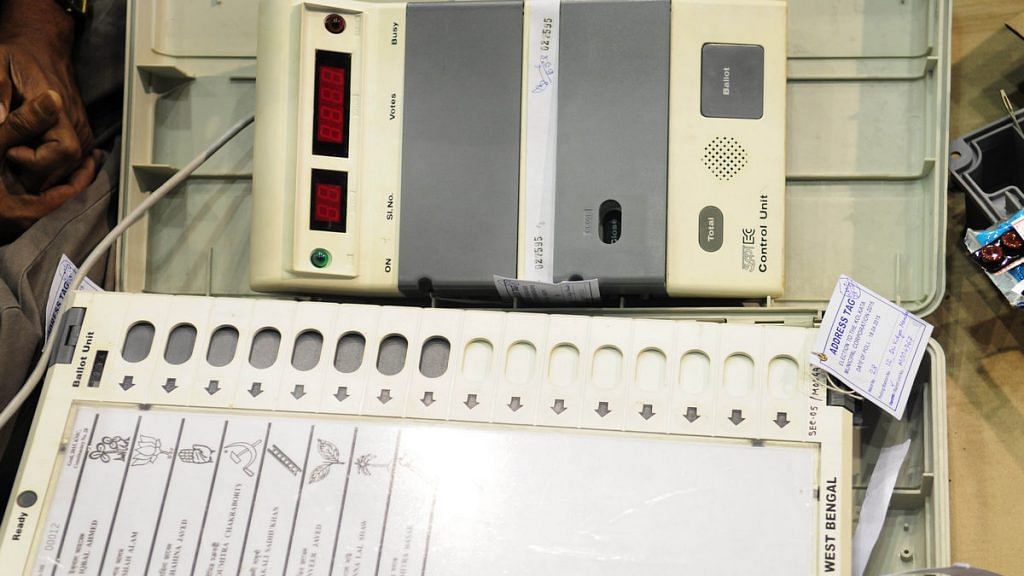New Delhi: A group of 73 former civil servants, including Indian Administrative Service (IAS), Indian Police Service (IPS), and Indian Foreign Service (IFS) officers, waded into the political row over electronic voting machines (EVMs) Sunday, writing an open letter to point out “serious shortcomings” in the implementation of the verifiable voter paper audit trail (VVPAT)-based audit of EVMs.
The letter, which comes months before the Lok Sabha elections, includes as signatories former national security adviser Shivshankar Menon, former foreign secretary Nirupama Menon Rao, former secretary in the finance ministry Narendra Sisodia, former IAS officer Aruna Roy.
According to the former civil servants, a parallel VVPAT tally of EVM results is essential to ensure free and fair elections, because “it is common knowledge that EVMs are ‘black boxes’ in which it is impossible for voters to verify whether their votes have been recorded and counted correctly”.
VVPAT is a physical record of every vote cast in an election.
The efficiency of EVMs becomes a hot topic of debate every election season, with the losing side often blaming “manipulated EVMS” for its defeat. In fact, the Congress moved the Election Commission (EC) last year to seek a return to paper ballots amid a “serious question mark on the credibility, independence and fairness of EVMs”.
Also read: EC unlikely to yield to opposition demand to verify 50% of EVM results with paper trails
However, the real issue today, the group of civil servants writes, “is not about “EVMs versus paper ballots” — according to them, it is about “EVMs with perfunctory VVPAT audit versus EVMs with proper VVPAT audit”.
In order to ensure that voting is free of possible EVM malfunction and manipulation, the group says, the EC must overcome a “series of serious shortcomings” in their VVPAT audit implementation.
The ‘short-comings’
First, the group says that the EC’s policy of using just “one polling station (i.e. 1 EVM) per assembly constituency” is a statistically incorrect sample size, because the number of EVMs in a constituency varies widely across states “from about 20 to about 300” and within the state itself.
For example, the group explains, Sikkim has 589 EVMs, Chhattisgarh has 23,672, and Uttar Pradesh, nearly 1,50,000.
Second, the retired bureaucrats point out, the EC has not made public “as to how it arrived at its sample size nor has it specified the population to which this sample size relates”. Sample sizes based on wide differences in population, they add, lead to “high margins of error” which “are unacceptable in a democracy”.
The EC has also “been vague about its ‘decision rule’ in the event of one or more defective EVMs turning up in the chosen sample”, and “failed to be transparent about the results of its VVPAT-based audit of EVMs for the various assembly elections held in 2017 and 2018”.
“The details are not available on its website,” the group writes.
“The lack of transparency in VVPAT-based audit of EVMs has fuelled various conspiracy theories about ‘mass rigging of EVMs,” the group writes.
Also read: India should put the EVM hacking debate to rest and here’s how
Most recently, the Europe chapter of the Indian Journalists’ Association (IJA) set up a live demonstration in London where a “US-based cyber expert” named Syed Shuja was to demonstrate how EVMs could be hacked.
Yet, Shuja, who claimed that every Indian election since 2014 had been rigged, failed to deliver what he had set out to show — a demonstration of how EVMs could be tampered with.
The way forward
The group writes that while large-scale EVM manipulation is highly improbable, “probability can increase significantly with insider collusion”.
For example, “potential attackers need to target only select EVMs to tip the balance in a few marginal, closely fought constituencies”, the group explains.
The group suggests that the EC adopt “a statistically correct sample size that can detect at least one defective EVM with 99.9 per cent reliability”.
Further, the retired civil servants also appeal that the EC create a framework for situations that demand full manual counting of VVPAT slips, including the results of closely-contested constituencies where the margin of victory is below 2 per cent of the votes cast or 1,000 votes, whichever is less, even if no defective EVM turns up in the sample
“Though the counting process may take a little longer, the confidence of the voters and political parties in the electoral process will be reinforced,” the group writes.
